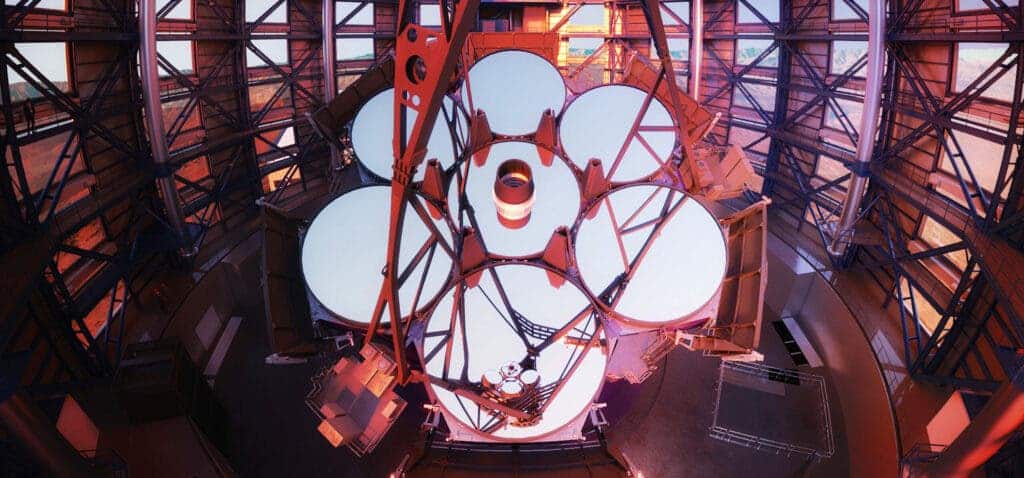The new and shiny James Webb Space Telescope has been all the rage these days, but a new contender is getting ready to steal the title of “most powerful telescope ever”: the Giant Magellan Telescope.

According to the Giant Magellan Telescope Organization (GMTO), which is handling the building project for the new telescope, the device will be four times more powerful than the James Webb when finished. GMTO has just obtained a new $205M funding infusion for the project — which is estimated to cost a total of $1 billion by its completion, — which will be used to speed up construction.
This is one of the largest funding injections the telescope has received since its founding, and the money will be spent on manufacturing the 12-story telescope structure that will be housed at the Las Campanas Observatory in Chile’s Atacama Desert.
Big lens
So why exactly will the Giant Magellan Telescope (GMT) be so powerful? Well, it mostly comes down to its size; although the James Webb has the favorable position in space, being a space-faring telescope means that there were strict limits placed on its size and weight. The GMT, as a land-based telescope, did not have to contend with these limits. As such, it has 10 times the light-collecting area of the James Webb, 4 times its spatial resolution, and 10 times the spatial resolution of the venerable Hubble Space Telescope.
All in all, this means that the GMT will be 200 times more powerful than any research telescope currently in operation, according to the GMTO.
We don’t currently have a clear timeline for when it will become operational, but this is expected to happen in the late 2020s. This last funding round is bound to speed that process along. According to the GMTO, there has been significant progress in the building efforts during the last few years.
“Six of seven primary mirror segments have been cast in Tucson, Arizona. The third primary mirror segment has completed its two-year polishing phase and is undergoing final testing. Construction of a 40,000-square-foot facility in Rockford, Illinois to manufacture the telescope structure is complete. The production of the telescope’s first adaptive secondary mirror is well underway in France and Italy, and the site in Chile is primed for the next stage of construction and pouring of the foundation,” the GMTO says.
“This latest $205 million investment round positions the Giant Magellan Telescope to be one of the first in a new generation of extremely large telescopes to be constructed. First light is anticipated by the end of the decade.”
When completed, the GMT will use seven of the world’s largest mirrors, each at a diameter of 8.4 meters, to create a mirror array 25.4 meters wide that will produce the most detailed images ever taken of outer space. The seven sub-mirrors will shift position to reshape the array with a maximum frequency of 2,000 times per second in order to allow it to correct the optical blurring effect of Earth’s atmosphere.

Its total light-collecting area will be 368 square meters, which, GMTO explains, will allow it to pick up the details engraved on a dime from 99 miles (160 kilometers) away.
The telescope mount will be 39 meters tall and weigh 2,100 tons, and the whole device will be held in a 65-meter enclosure that can complete a full rotation in around three minutes.
“This unprecedented angular resolution, combined with revolutionary spectrographs and high contrast cameras, will work in direct synergy with JWST to empower new scientific discoveries,” the GMTO says.
The new investment includes leading commitments from the Carnegie Institution for Science, Harvard University, the São Paulo Research Foundation (FAPESP), The University of Texas at Austin, University of Arizona, and the University of Chicago. It came hot on the heels of the National Academy of Sciences Astro2020 Decadal Survey which ranked the program a top priority and considers it “absolutely essential if the United States is to maintain a position as a leader in ground-based astronomy.”
“We are honored to receive this investment in our future,” said Dr. Robert Shelton, President of Giant Magellan Telescope. “The funding is truly a collaborative effort from our Founders. It will result in the fabrication of the world’s largest mirrors, the giant telescope mount that holds and aligns them, and a science instrument that will allow us to study the chemical evolution of stars and planets like never before.”


